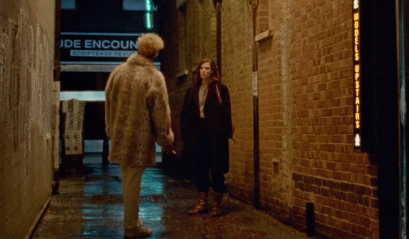"The Souvenir Part II" Explores Emotional Fallout
The bookend installment of Joanna Hogg's poignant autobiographical memoir poses the question, "Is this all there is?"
If The Souvenir is about a painful first romance, the careless abandon with which addiction destroys love, and the insidious lies such a destructive force tells in the name of shame, Joanna Hogg’s sequel is a master class on how to move past loss.
The story picks up moments after Anthony’s overdose in the bathroom of the Wallace Collection, where he and Julie went on their first date and traded prescient observations on the famed painting, “The Souvenir.”
In contrast to the first film, which despite its tragic end still presents a tale of passion and the alluring lack of inhibition that comes with the early stages of intimacy, this one presents a more sobering look at what happens next. The quiet and sensitive Julie, now pursuing her capstone film project - a memorial for Anthony, doesn’t demand answers. That’s not how she moves about in the world. Instead, she’s thoughtfully posing the very questions that seek to reveal who her paramour was, from those who supposedly knew him better, like his parents and his addict friends. In the end, Julie has limited material to draw from as she attempts to craft her film, presenting challenges in the creative process.
To gain more certainty about Anthony’s character, Julie even interrogates her mother, Rosalind, about how she feels about Anthony’s death. In another magnificent performance from Tilda Swinton, as a mother nurturing her child through grief, Swinton, as Julie’s mother, responds slowly, “I was very concerned for you. I felt through you.” It’s such a moving scene because the raw and palpable anguish of a parent's empathy for their child's suffering is so brilliantly conveyed through a seemingly ordinary conversation on a couch. Rosalind addresses every question Julie tosses at her with a profoundly delicate delivery.
Julie’s Relationships with Others
As is the case with the first film, the most interesting interactions Julie has are often with the egoist filmmaker and truth sayer Anthony’s pal, Patrick, played by Richard Ayoade who has a more prominent role in this film, thankfully. Towards the end of the film, as they catch up on their projects, Julie, acts as a stand-in for the audience, posing a question that is on our minds, in a desire to know him better:
Julie: Did you think Anthony did work for the Foreign Office? In the end?
Patrick: Anthony was a junkie.
Julie: Yeah.
Patrick: Okay. Onwards.
[Julie nods her head in acquiescence and walks offscreen.]
The question and its response encapsulate the essence of Julie’s fruitless quest and its inevitable conclusion. She will never know Anthony completely. This is compounded by the fact that Anthony was in equal parts charming and manipulative. And of course, as Patrick points out, “a junkie.”
The memo: To do her film project, she must rely on her experience, solely. That is the only truth.
In this way, the story is about Julie’s finding her voice in her evolution from a less sure-footed film student to an up-and-coming film/ music video director. As Julie’s working on Anthony’s memorial film project, she must face her share of verbal reproaches and criticisms from those working on the film - some harsher than others - but it’s also evident that some believe in her abilities, like her peer Marland and even her lead actor, playing the role of Anthony in her film, Pete (Harris Dickinson, A Murder at the End of The World), who gently nudges her to reconcile the different versions of Anthony - the person he was and the person she knew.
The Anti-Romance + Anti-Hero Anthem
Romantic love isn’t “the thing” in this film. The sole sexual hook-up happens near the beginning and it’s a peculiarly empty one. Julie meets a famous actor, Jim (Charlie Heaton, Stranger Things), who knew Anthony. Like Julie, he’s a person of few words and a deep feeler. What is discerned via heated glances between them is that there’s a strong physical attraction. One night, unplanned, Jim shows up at Julie’s door in what I can only describe as a dreaded moment of sheer panic for the prognosis of the rest of the film, where you wonder if this is the start of what will be a series of emotionally irresponsible hookups (not to mention sexually unsafe) for Julie. It’s not. There is some bloody Cunnilingus though, so you’ve been forewarned. Also, the lack of a verbal or physical “goodbye” was more jarring than the bloody mouth.
Moving On
In this film about moving on, Hogg deliberately links Julie's personal growth to her emancipation from the need for romantic fulfillment. When Julie tells her therapist she wants to know intimacy again, her therapist suggests broadening her social circle beyond film school and taking calculated risks to develop new habits, which could foster deeper connections and intimacy.
In the final twenty minutes, Hogg juxtaposes her own poetic and dramatic cinematic vision against the screening of Julie's film - a memorial to her relationship with Anthony. It’s a meta moment that also functions as a trompe l’oeil, deceiving us but presenting an analogous truth. Hogg’s masterpiece is told from Julie’s perspective where she’s the star or “the main character” (as the kids like to say), appearing almost in goddess-like form, floating through the tragic scenes of her life with Anthony against an operatic sound.
It’s haunting and beautiful, which is a good way to describe this film’s effect. Julie’s real-life inspiration, Hogg, found a way to move on to a meaningful film career, making movies that matter to her and others like me.











You convince me to watch films I would normally pass by. Another one you've written about on my 'must watch' list!